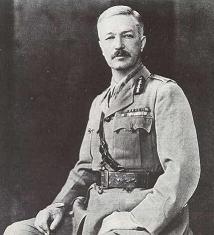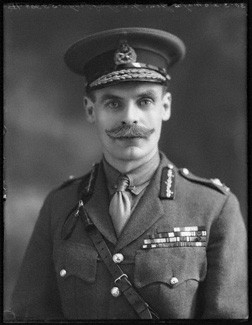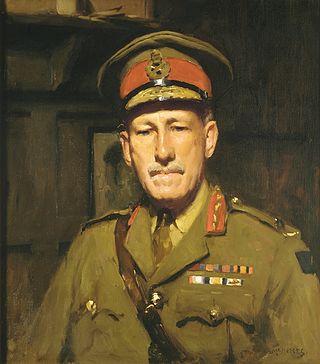Related Research Articles

Colonel Reginald Edward Harry Dyer, was an officer of the Bengal Army and later the newly constituted British Indian Army. His military career began in the regular British Army but he soon transferred to the Presidency armies of India. As a temporary brigadier-general, he was responsible for the Jallianwala Bagh massacre that took place on 13 April 1919 in Amritsar. He has been called "the Butcher of Amritsar", because of his order to fire on a large gathering of people. The official report stated that this resulted in the killing of at least 379 people and the injuring of over a thousand more. Some submissions to the official inquiry suggested a higher number of deaths.
Sir John Reginald Hornby Nott-Bower was Commissioner of Police of the Metropolis, the head of the London Metropolitan Police, from 1953 to 1958. He was the first career police officer to hold this post.

The Commander-in-Chief, The Nore, was an operational commander of the Royal Navy. His subordinate units, establishments, and staff were sometimes informally known as the Nore Station or Nore Command. The Nore is a sandbank at the mouth of the Thames Estuary and River Medway. In due course the Commander-in-Chief became responsible for sub-commands at Chatham, London, Sheerness, Harwich and the Humber.

George Darell Jeffreys, 1st Baron Jeffreys, was a British Army officer and Conservative Member of Parliament.

Major General Charles Henry Brand, was an Australian Army officer and politician. He rose to the rank of brigadier general in the First World War, retired as a major general in 1933 and was elected to the Australian Senate representing Victoria for the United Australia Party from 1935 to 1947.

Petersfield was an English Parliamentary constituency centred on the town of Petersfield in Hampshire. It existed for several hundred years until its abolition for the 1983 general election.
Charles Murray Padday, RI, ROI (1868–1954) was a British artist and illustrator. He was particularly known for his sea paintings.
Major General Edward Bailey Ashmore, was a British Army officer from the 1890s to the 1920s who served in the Royal Artillery, the Royal Flying Corps and briefly in the Royal Air Force before founding and developing the organisation that would become the Royal Observer Corps.

Lieutenant General Sir Reginald Francis Stewart Denning, was a British Army staff officer and administrator.

Fred Winchester Sladen was career United States Army officer who rose to the rank of major general and became Superintendent of the United States Military Academy. He was a son of English-born Joseph A. Sladen (1841-1911) and Martha F. Winchester. The elder Sladen met with Cochise in the company of General Oliver Otis Howard, and was awarded the Medal of Honor for his service in the American Civil War.
Lieutenant General Sir Roderick William McLeod, was a British Army officer who achieved high office in the 1950s.

Admiral Sir Vernon Harry Stuart Haggard, KCB, CMG was a Royal Navy officer who went on to be Commander-in-Chief, America and West Indies Station. His career in the Royal Navy spanned forty-four years, from his entry as a youth in 1888 to his promotion to admiral in 1932.

Brigadier John Murray Rymer-Jones was a British Army and police officer.
General Sir Charles Bonham-Carter, was a British Army officer and later Governor of Malta.

General Sir Reginald John Thoroton Hildyard, was a British Army officer who saw active service in the Second Boer War and the First World War. He was Governor and Commander-in-Chief of Bermuda from 1936 to 1939.
General Sir Reginald Byng Stephens, was a British Army general of the First World War and later Commandant of the Royal Military College, Sandhurst, from 1919 to 1923, Major-General commanding the 4th Division, 1923 to 1926, and Director-General of the Territorial Army, 1927 to 1931.
Commander Sir Aylmer Newton George Firebrace, was a British Royal Navy officer and fire chief. As a Royal Navy officer, he saw active service in World War I and participated in the Battle of Jutland. Following the war, he joined the London Fire Brigade and rose to become its Commander. With the creation of the National Fire Service, he became the first and only person to head firefighting across the whole of Great Britain.
Major-General Sir Reginald Walter Ralph Barnes was a cavalry officer in the British Army. He served in several regiments, and commanded a battalion of the Imperial Yeomanry, the 10th Royal Hussars, the 111th Brigade, and three divisions.
Reginald Edgar Gilbert Fulljames MC was an English cricketer and an officer in both the Royal Flying Corps (RFC) and the Royal Air Force (RAF), serving in both world wars.

Brigadier-General Norman Reginald McMahon was a British Army officer. He served with the Royal Fusiliers in the Burma expedition of 1886–87 and in the Second Boer War of 1899–1902. During the latter campaign he served on the general staff as an aide-de-camp and then brigade major. McMahon was seriously wounded in action and was subsequently mentioned in dispatches and awarded the Distinguished Service Order. Once recovered he served as Deputy Assistant Adjutant General towards the end of the war.
References
- 1 2 3 'Obituary', The Times , 15 May 1951, page 8
- ↑ "RG 11 - 1881 Census Returns - HAMPSHIRE - Registration District 106.ALTON". National Archives.
- ↑ "RG 12 - General Register Office: 1891 Census Returns - Subseries within RG 12 - KENT - Subsubseries within RG 12 - Registration District 62.THANET". National Archives.
- ↑ "RG 14 - General Register Office: 1911 Census Schedules - Subseries within RG 14 - London - Subsubseries within RG 14 - St Pancras - Part 29". National Archives.
- ↑ 'The London Sewer Accident - Resumed Inquest and Verdict', The Times, 8 April 1913, page 4
- 1 2 'New Chief of London Fire Brigade', The Times, 2 June 1919, page 18
- ↑ The Times, 5 June 1919, page 14